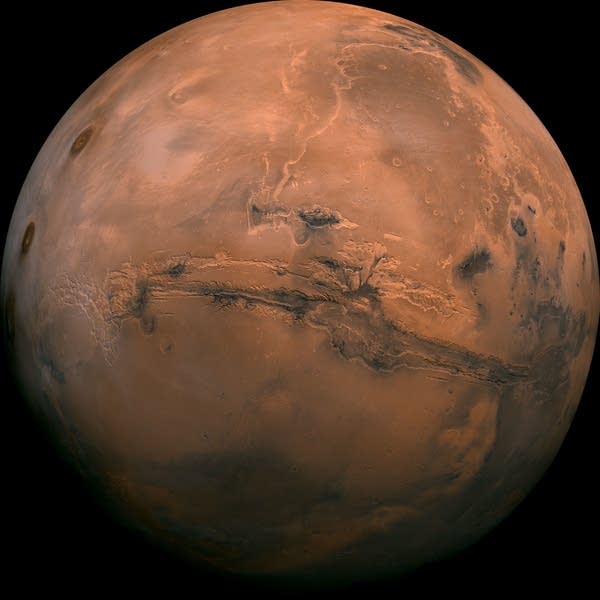Ask a science teacher with Jill Jensen

Go Deeper.
Create an account or log in to save stories.
Like this?
Thanks for liking this story! We have added it to a list of your favorite stories.
Did you know scientists use lynx scat to track their population size? Or that there are two different shapes of snowflakes on planet Mars? Or that a very special species of frog turns transparent when it sleeps? Sometimes you just need to ask a science teacher to find out more.
Jill Jensen is the president of the Minnesota Science Teacher’s Association, and a 7th grade life science teacher at Scott Highlands Middle School in Apple Valley, Minn. She joined host Cathy Wurzer to talk about the latest news in science.
Use the audio player above to listen to the full conversation.
Subscribe to the Minnesota Now podcast on Apple Podcasts, Google Podcasts, Spotify or wherever you get your podcasts.
We attempt to make transcripts for Minnesota Now available the next business day after a broadcast. When ready they will appear here.
Turn Up Your Support
MPR News helps you turn down the noise and build shared understanding. Turn up your support for this public resource and keep trusted journalism accessible to all.
Audio transcript
Well, Jill welcome.
JILL JENSEN: Hi, thanks for having me.
INTERVIEWER: About this snow. We know it snows on Mars. And scientists learned some new things, though, about that snow. So tell us about that.
JILL JENSEN: Yeah, so Mars actually has two kinds of snow. They have water ice, which is what we have here on Earth. But the Mars atmosphere, because it's so cold and because of what the Mars atmosphere is made up of, they actually get carbon dioxide snow as well. And the interesting thing about carbon dioxide snow is because of the molecular structure of carbon dioxide, it actually forms cubes instead of the six-sided snowflakes that we're used to.
INTERVIEWER: OK, so cubes. All right, that would be interesting.
JILL JENSEN: Imagine almost like a field of like salt grains, or something.
INTERVIEWER: OK, so let's move on to another story a little closer to home. Minnesota has lynx, but their numbers are falling. But there's some good news.
JILL JENSEN: There is. So scientists have been tracking lynx. Lynx are really hard to find. They're solitary creatures. They don't tend to attack wildlife or humans. So they just tend to keep by themselves. Their numbers were thought to be pretty low.
But one of the best ways to actually track them is by collecting their scat. And through their scat collection, scientists have been doing this for over 20 years now and sending it to a DNA database in Montana. And they've been able to get lots of information to help estimate the population.
They can tell what families of lynx are around and how many are surviving. And they're really hoping to use this information to make a recovery plan for them. So lynx have been on the threatened species list for about 22 years now
INTERVIEWER: OK, and kind of like-- this is like tracking human wastewater during COVID? I mean, you can find a lot through waste.
JILL JENSEN: Yeah, right. So there's actually quite a bit of information they can tell. They're actually able to tell how many they have, how many kittens they have, how many are surviving, how many different specific species there are. And it actually has been able to give them a better idea of what their population is. And yes, as you said, wastewater from humans also gives us lots of clues as to what's going on with COVID as well. So lots of information kind of hiding in our waste.
INTERVIEWER: Let's hear about some more animal news. This is a fun story about frogs in the rainforest.
JILL JENSEN: Yeah, there's a type of frog called a glass frog which lives in the tropical rainforests of Central and South America. They're only a few centimeters big. And they're mostly active at night. And they're called glass frogs because the skin on their abdomen is transparent. So if you were sitting underneath it and looked up, you'd be able to see all of its organs.
So one way that it has developed to help itself blend in is by hiding all of its blood while it's sleeping into its liver. And so that makes it really transparent and really be able to hide from predators. And this is interesting to scientists because they can do this without damaging their peripheral organs or tissues. And they don't seem to suffer from any blood clots. So if we could figure out the magic of the blood work of that glass frog for humans, we could have some good health news for people suffering from some blood disorders.
INTERVIEWER: Interesting. Say by the way, before you go, what are you teaching in the classroom?
JILL JENSEN: We are in the middle of our chemistry unit. So we are looking at periodic table, and atoms and atom structures, and then how they combine to make molecules and compounds. But the story about Mars has been particularly interesting because we actually just finished watching The Martian and are thinking a lot about what life would be like on Mars and if we'd like to go and explore there someday.
INTERVIEWER: All right. I appreciate you joining us, Jill. Thank you so much.
JILL JENSEN: Yeah, thank you. Glad to be here.
INTERVIEWER: Jill Jensen is a seventh grade science teacher at Scott Highlands Middle School in Apple Valley. She's the president of the Minnesota Science Teachers Association. To read more about any of these science stories that we talked about, we have links on our website mprnews.org.
Download transcript (PDF)
Transcription services provided by 3Play Media.




